- One of the best words to describe Amazon wildlife, including large mammals and birds, is cryptic.
- A person can spend a day trekking through the dense green and brown foliage of the Amazon and see nothing more than a few insects, maybe a frog here and there if they have good eyes.
- In fact, researchers have spent years in the jungle and never seen a jaguar, let alone a tapir.
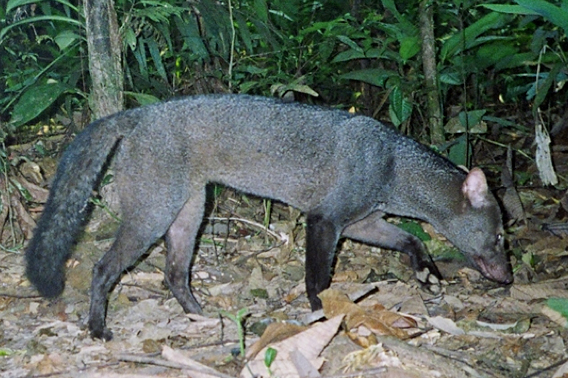
One of the Amazon’s most elusive and least-known mammals, the short-eared dog (Atelocynus microtis), captured on camera trap by the Tiputini Biodiversity Station (TBS). Photo courtesy of TBS.
One of the best words to describe Amazon wildlife, including large mammals and birds, is cryptic. A person can spend a day trekking through the dense green and brown foliage of the Amazon and see nothing more than a few insects, maybe a frog here and there if they have good eyes. In fact, researchers have spent years in the jungle and never seen a jaguar, let alone a tapir. Some species like the bushdog and the giant armadillo are even more cryptic. Almost never encountered by people, in some parts of the Amazon they have taken on a mythic status, more rumor around the fire than reality. However, camera traps—automated cameras that take a flash photo whenever an animal triggers an infrared sensor—in the Amazon have begun to reveal long-sought information about the presence and abundance of species, providing new data on range and territories. And even at times giving glimpses into the private lives of species that remain largely shrouded in mystery.
The Tiputini Biodiversity Station (TBS) rests in the Ecuadorian jungle across the river from Yasuni National Park. Here a camera trap program has led to a wealth of information, resulting in several research papers (see list at the end of the interview), on an area of the Amazon that is largely intact.
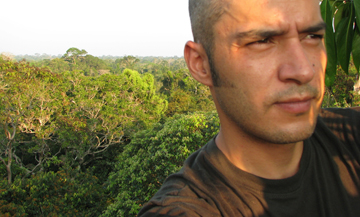 Diego Mosquera. Photo courtesy of TBS. |
“The goal was to develop baseline information before human activities increased in the region. TBS is, to date, largely unaffected by human activities, but this may change if hunting pressures or oil exploration increase,” Diego Mosquera, site manager at TBS, told mongabay.com. Before the camera traps, accumulating baselines data on so many species would have been impossible. “We started the program in December 2004, and its a pioneer study of this kind in Ecuador. We have over 30,000 pictures to date and we are working on determining densities of cats, mainly jaguars and ocelots, something never done in Ecuador. According to preliminary data, densities of both species are remarkably high at the station.”
To gather such data, the program has focused in part on mineral licks around the site. Species visit these licks in order to consume minerals they can’t get anywhere else.
“As expected, we captured a variety of fauna visiting the licks and wallows, including a surprising abundance of red brocket deer, tapirs, collared peccaries, white-lipped peccaries, howler monkeys and spider monkeys. The presence of these animals definitely tells us something about their apparent need for certain minerals, but also hints at a social function of such sites for many organisms,” says Kelly Swing.
The program has also captured a number of photos of species that are almost never recorded, such as the short-eared dog, the bushdog, the nocturnal currasow, and the dark tree rat. Given their rarity and difficultly almost nothing is known about these animals.
 Kelly Swing. Photo courtesy of TBS. |
“With the trap cameras sometimes you can get some insights into their behavior. The few images we have of these two canines [short-eared dogs] can tell us quite a bit about where and when they are active. In one case, we’ve even documented a predation event and can identify the consumption of an odd amphibian called a caecilian by the short-eared dog,” says Kelly Swing.
The camera trap program has proven such a success that TBS is now considering upgrading to include video camera traps.
“We realized the potential of having video cameras when once, by accident, we set one of the old digital cameras on video instead of still picture mode. We got over 200 8 sec videos, most of them at night, so you could not see anything. However, 3 of them, recorded during the day, turned out to be amazing,” Mosquera says. Funding and building video camera traps are the two obstacles to implementation.
The station has sorted through thousands of photos, some blurry and indistinguishable, and others showing remarkable scenes of wildlife that no human eye has ever caught. For Mosquera, though, his favorite image was the one that proved there was black jaguar, more popularly known as a panther, in the area.
In a May 2011 interview Diego Mosquera and Kelly Swing discussed the challenges of camera trapping, the new discoveries the technique has yielded, and hopes for the future of the program.
AN INTERVIEW WITH DIEGO MOSQUERA AND KELLY SWING
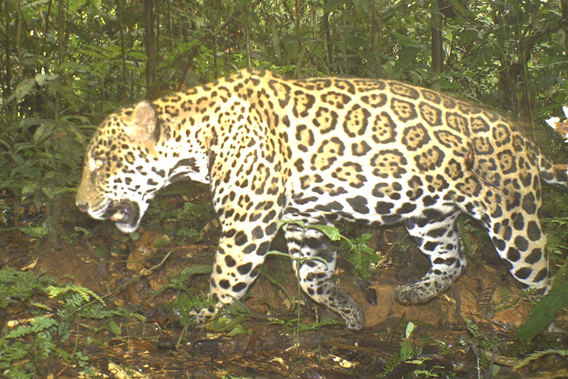
Top predator and America’s biggest cat, the jaguar (Panthera onca) caught on camera trap at TBS. Photo courtesy of TBS.
Mongabay: What are your backgrounds?
Diego Mosquera: I have a degree in Applied Ecology and I am finishing a Masters in GIS (Geographic Information Systems).
Kelly Swing is the Director of the Station. He has a PhD in Zoology and has worked and lived in Ecuador for the last 20 years.
Mongabay: What makes Tiputini Biodiversity Station (TBS) unique?
Diego Mosquera: Tiputini is located in the heart of Ecuadorian Amazon, adjacent to the Yasuni National Park, known to be one of the most biodiverse places on earth.
CAMERA TRAP DISCOVERIES
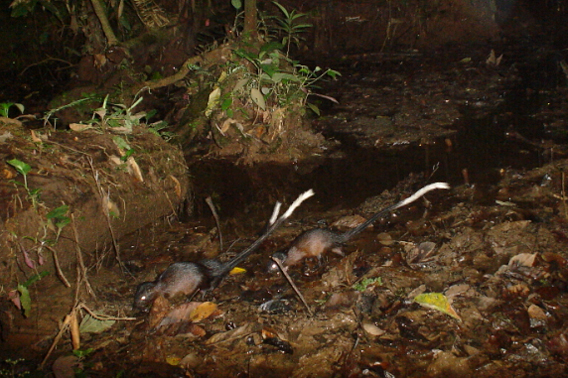
Photos of dark spiny tree rats (Echimys saturnus) at Tiputini was the first evidence of the species in this locale. Photo courtesy of TBS.
Mongabay: What led to the decision to begin camera trapping at Tiputini?
Diego Mosquera: Our main objective of the current project was to initiate a long-term monitoring program with camera traps to provide information on occurrence, distribution, and relative abundance of large terrestrial mammals and birds, and how those patterns vary over time. The goal was to develop baseline information before human activities increased in the region. TBS is, to date, largely unaffected by human activities, but this may change if hunting pressures or oil exploration increase. A second objective was to document the importance of mineral licks (saladeros) as a resource for different species and how the use of such licks varies not only among species but also across seasons. Natural mineral licks may be keystone resources for some species but are both spatially and temporally variable in occurrence. Further, given that hunters may target such areas, documentation of their importance may facilitate efforts to preserve such sites whenever possible.
We started the program in December 2004, and its a pioneer study of this kind in Ecuador. We have over 30,000 pictures to date and we are working on determining densities of cats, mainly jaguars and ocelots, something never done in Ecuador. According to preliminary data, densities of both species are remarkably high at the station.
Mongabay: What did you learn about clay licks by setting up cameras there?
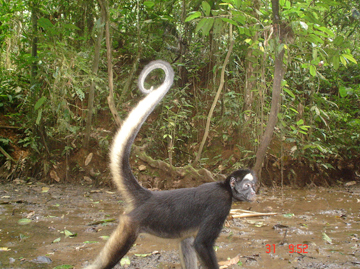 A spider monkey captured on cameratrap in a rare momento on the ground seeking minerals from the clay lick. Photo courtesy of TBS. |
Kelly Swing: As expected, we captured a variety of fauna visiting the licks and wallows, including a surprising abundance of red brocket deer, tapirs, collared peccaries, white-lipped peccaries, howler monkeys and spider monkeys. The presence of these animals definitely tells us something about their apparent need for certain minerals, but also hints at a social function of such sites for many organisms.
Mongabay: Your camera traps have documented red howler monkeys and white-bellied spider monkeys feeding at clay licks. What is the significance of this behavior?
Kelly Swing: The fact that primates come to the ground to drink water and/or consume the substrate implies that the necessity to obtain some compound(s) there is greater than the risk of coming down out of the trees where they are much more agile and protected.
Mongabay: You’ve captured two of the rarest, most mysterious Amazonian mammals on camera: the short-eared dog and the bush dog. How much of a surprise was this?
Diego Mosquera: We knew that both species were extremely rare. We were expecting to capture them in the cameras, but we didn’t expect to get so many pictures of the short-eared dog, in some cases both male and female are pictured two minutes apart. We’ve only captured the bush dog twice, but so little is known of these two species and so few studies have been done that any data are very important for the understanding of their behavior and ecology, and therefore, their conservation.
Mongabay: Have the photos revealed any insights into these largely unknown animals’ behavior?
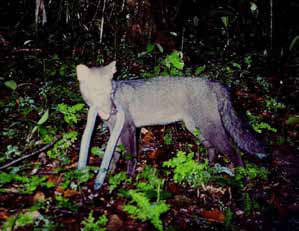 Weird encounter: a short-eared dog preying on a giant worm-like amphibian, the caecilian. Photo courtesy of TBS. |
Kelly Swing: Obviously, observations in the field are the main way to approach the behavior of a species. However, with the trap cameras sometimes you can get some insights into their behavior. The few images we have of these two canines can tell us quite a bit about where and when they are active. In one case, we’ve even documented a predation event and can identify the consumption of an odd amphibian called a caecilian by the short-eared dog. For the same species, we have been able to collect data on the seasonality of breeding and have confirmed that males and females remain together during the time of taking care of the offspring.
Diego Mosquera: I would suggest that these camera traps are more important for documenting population density, presence of species and main hours of activity than specific behavior, other than maybe the role of paternal care when you get images of parent and offspring. I guess they can tell about territoriality and food preference too, but that’s more ecology, not behavior.
Mongabay: Has the camera trapping program revealed any other new information about other species’ behavior?
Diego Mosquera: We recorded species feeding on prey that had not been described previously for them and recorded several pictures of animals within specific territories during several occasions, which suggests that they are territorial, a fact that was unclear before. We also have pictures that include parents and offspring, which in some species is an indicator of parental care up to a certain point in their lives. In other cases, for example, we recorded certain bird species on the ground, an unusual behavior for them.
Mongabay: You also caught the nocturnal curassow and the dark spiny tree rat on camera. Why were these photos notable?
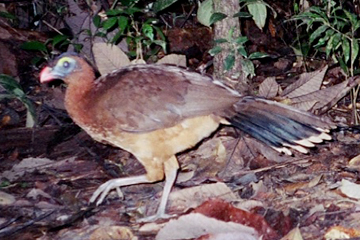 Nocturnal currasow (Nothocrax urumutum). Photo courtesy of TBS. |
Diego Mosquera: The nocturnal curassow is a very secretive and elusive bird, and only a few people have ever seen it. It is active mostly at night, which is why it is extremely hard to see although it is easily audible through the darkness. As far as we are aware, we obtained the first pictures of this bird in its natural habitat, at least in Ecuador, which is notable. The dark tree rat is a poorly known rodent and all accounts of this species come from 10 or fewer specimens from a small geographic range, back in the 1930s. This certainly suggests that this species is rarely encountered. Our records of this species are the farthest east and the lowest elevation, and it is the first report of this species from lowland forest in eastern Ecuador.
Mongabay: Given the diversity of species and the frequency photographed, how would you characterize the health of the area’s forests?
Diego Mosquera: We have recorded a great number of species, some with higher frequency than others, but this certainly is an indicator that the forest is in good health. There are species that are highly susceptible to changes in the forest, and disappear once it is disturbed such as Salvin’s curassow of which we have a good number. The amount of pictures of big cats (jaguars, pumas) also suggests that the forest in still in good shape, since these predators require large amounts of prey, only available when the forest is “healthy”.
Mongabay: What is your favorite photo?
Diego Mosquera: There a lot pictures that I like. In general, I always like having pictures of cats, like jaguars, pumas and ocelots, but maybe my favorite is the one of a black jaguar (panther)…
THE PRACTICALITIES OF CAMERA TRAPPING
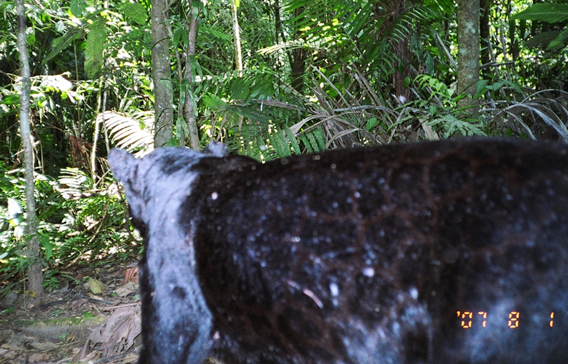
The black jaguar that stalks Tiputini from time to time. Photo courtesy of TBS.
Mongabay: What advice would you give for other research stations or organizations interested in starting camera trapping?
Kelly Swing: This endeavor can be extremely rewarding or extremely frustrating depending on two main aspects of the place. One is obviously the abundance of wildlife. At our site, the project has been most productive as far as total number of images and the total number of species represented. At other sites, I’ve heard too many lamentations of all the walking, kilometers and kilometers, to harvest no images at all or just a few. Also, in some places, people come to be problematic, because of camera vandalism or theft.
Mongabay: How would you characterize the benefits of camera trapping for researchers?
Diego Mosquera: Camera traps are a good way to study wildlife because it is a non-invasive technique, and therefore captures natural, unaltered behavior, unlike, for example, using bait to attract them. Even though they can be expensive to purchase, once the cameras are set they can provide data over long periods of time at relatively low costs. Ultimately, the time and money invested is low compared to the wealth of data you are collecting.
Mongabay: At first you used both film and digital, but then moved to only digital photos. Why?
Diego Mosquera: At the beginning of the project, our budget was limited, so we decided to acquire only a few digital cameras (due to high cost) and most of our cameras were film-based. Having a digital camera is a more practical option since you get the pictures right away and avoid having to develop the film. With digital cameras, you can collect a lot more images (depending on the size of the memory card) between visits to trap sites than with film cameras (which at best would max out at 36-38 photos). Also, depending on the camera, the quality of the pictures can be better. For the second stage of the project, we replaced all the cameras in the field and at the moment we only use digital cameras. Their cost has decreased and their technology has improved, so it is the best option for us. And we have eliminated entirely the costs of film, processing and digitizing.
FUTURE
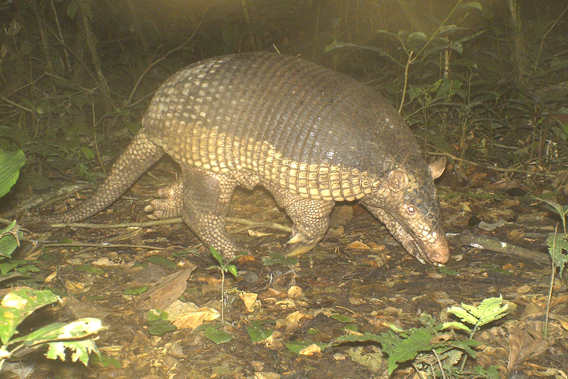
A giant armadillo (Priodontes maximus), about the size of a medium-large sized dog, on camera trap at TBS. Photo courtesy of TBS.
Mongabay: You’ve considered setting up video cameras. What would be the advantage of this?
Diego Mosquera: We realized the potential of having video cameras when once, by accident, we set one of the old digital cameras on video instead of still picture mode. We got over 200 8 sec videos, most of them at night, so you could not see anything. However, 3 of them, recorded during the day, turned out to be amazing. Having video cameras provides a lot more information about the animal’s behavior than a simple picture and gives you a better understanding of its habits in the forest.
Mongabay: What are the obstacles to implementing a video camera trapping program?
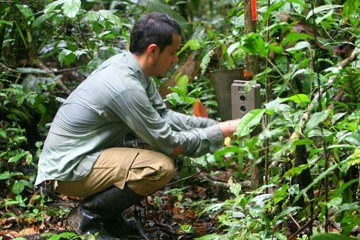 Researcher resetting camera trap at TBS. Photo by: Jeremy Hance. |
Diego Mosquera: The main obstacle is, of course, having the budget to do it. Also, video-trap cameras are not commercially available yet and it has been difficult to identify potential sources. One possibility is to build the cameras yourself, which we know has been done before. At the moment we are looking into some possibilities to build them and we have already contacted some people interested in helping us to do it.
Mongabay: Is there any species you haven’t caught on camera that you would love to see?
Kelly Swing: We have recorded over 60 species so far, but there are certainly many others that are roaming our forests that we’d like to see in the images. We have likely already captured images of most of the large terrestrial species but we’re quite interested in confirming the presence of other small species of mammals as well. There are many denizens of the forest that do not come to the ground often due to their association with the forest canopy but undoubtedly some of the eagles do come to the ground to capture or feed on prey. It would be wonderful to get images of any of those raptors struggling with a snake or a monkey a little too heavy to carry.
Recent research papers produced from data gathered from Tipitini’s camera-trap program:
John G. Blake, Diego Mosquera, Jaime Guerra, Bette A. Loiselle, David Romo and Kelly Swing. Mineral Licks as Diversity Hotspots in Lowland Forest of Eastern Ecuador. Diversity. Volume 3, 217-234. 2011. doi:10.3390/d3020217.
John G. Blake, Diego Mosquera, Jaime Guerra, and David Romo. New locality records and the first photographs of living Echimys saturnus (dark tree rat, Echimyidae) from eastern Ecuador. Ecotropica. 16: 141–144, 2010.
John G. Blake, Jaime Guerra, Diego Mosquera, Rene Torres, Bette A. Loiselle, and David Romo. Use of Mineral Licks by White-Bellied Spider Monkeys (Ateles belzebuth) and Red Howler Monkeys (Alouatta seniculus) in Eastern Ecuador. International Journal of Primatology. Volume 31, Number 3, 471-483, DOI: 10.1007/s10764-010-9407-5.
Diego F. Cisneros-Heredia, Diego Mosquera, First record of a canid (Atelocynus microtis) predating on a caecilian amphibian. Avances en Ciencias e ingenierias. Volume 2, Number 3. December 2010.
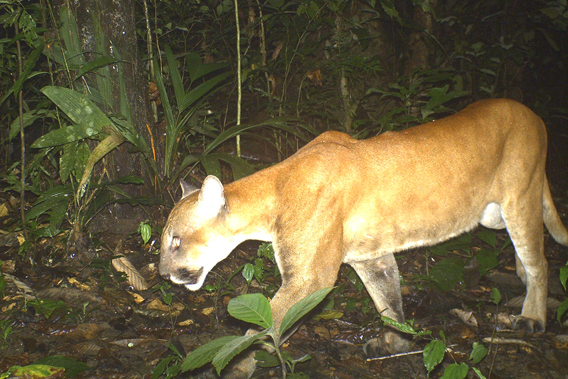
A puma. Photo courtesy of TBS.
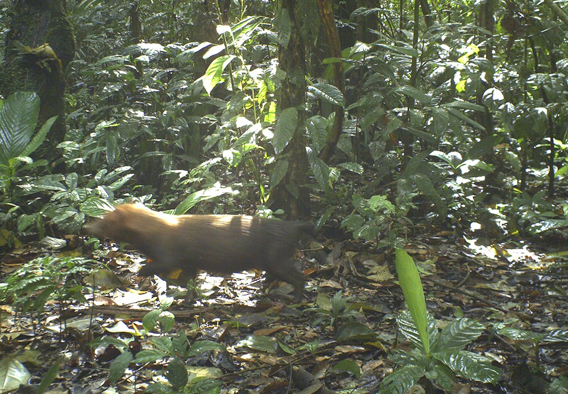
The cryptic and rare bush dog. Photo courtesy of TBS.
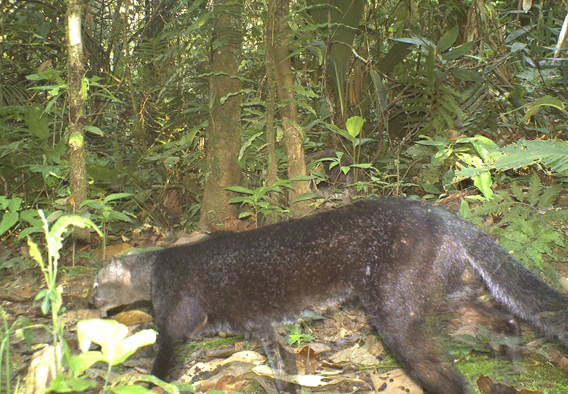
A jaguarundi. Photo courtesy of TBS.
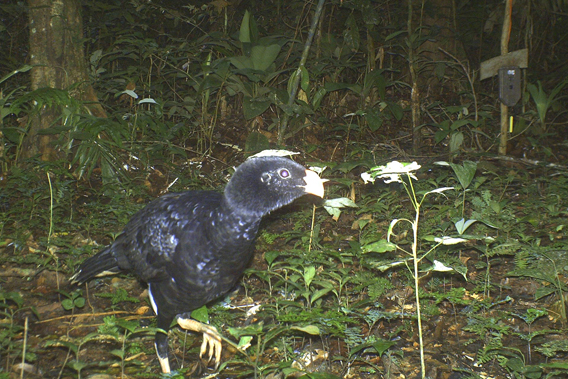
Salvin’s currasow. Photo courtesy of TBS.
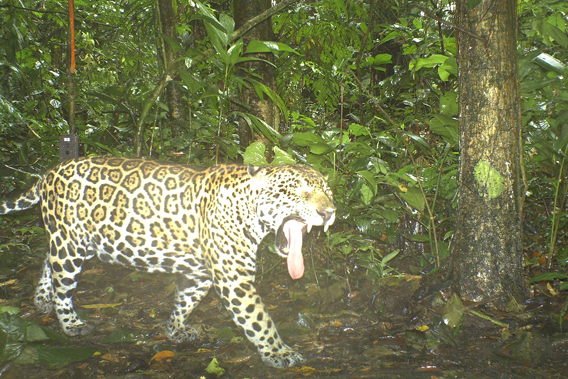
Another jaguar. Photo courtesy of TBS.














